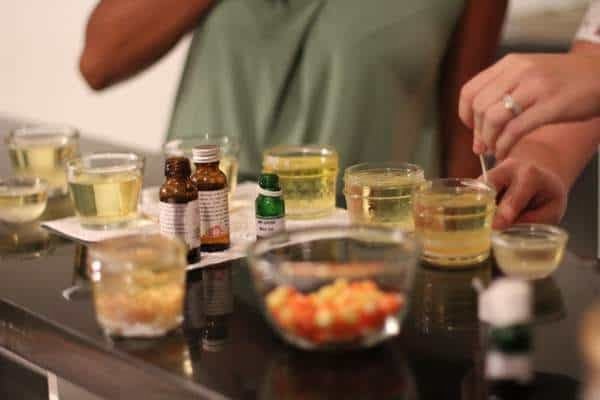Introduction
Making scented oils for candles is an easy, inexpensive way to customize the fragrance of your candles and bring a unique aroma to any room. Scented oils add flavor to your candles and can be used as an all-natural alternative to artificial fragrances. With just a few common household items, you can create a variety of homemade scented oils that are perfect for adding to your own batch of custom-scented candles. Scented oils can also add a special touch to gifts or elevate aromatherapy practices.
Types of Scented Oils
When it comes to scented oils used in candle making, the choices are almost endless. Some of the most popular types of scented oils include:
• Essential Oils ” These are derived from plants and their properties depend on the plants they’re extracted from. Generally, they have a strong fragrance intensity and moderately good diffusion, with a moderate duration.
• Fragrance Oils ” Also known as aroma oils, these artificial scent compounds tend to be very affordable, but also offer an intense fragrance and excellent diffusion. The duration can be long-lasting too.
• Designer Scented Oils ” These are usually custom blends of various ingredients and offer a unique scent with an even better endurance than synthetic or essential oils. They tend to possess a mild-moderate fragrance intensity, but their diffusion and duration make them an ideal choice for many candle makers.
• Plant Based Oils ” This type of oil is obtained directly from fruits and flowers by extractions or distillation processes. Their fragrance intensity and diffusion may not be as strong as those provided by other types of scented oils, but their duration tends to be longer than average.
Preparing the Oils
The preparation of oils for candles is best done by dilution and emulsification. For the dilution process, mix an appropriate quantity of the candle oil with other ingredients such as light oils, alcohol or water. The result should be a consistent viscosity that has the desired scent strength.
Emulsification is also an important step in preparing scented oils for candles. This is done to bind together two non-mixable liquids, allowing them to form a smooth and stable mixture suitable for use in candles. In this process, a surfactant such as polysorbate 80 is added to the candle oil and then mixed with other liquid components until they are evenly combined. Once they have been completely mixed together, they should form a homogenous blend that has the desired scent strength. This can even be tested using a pH meter or dropper if necessary.
Safety Considerations
When making scented oils for candles, it is important to consider safety. Scented oils are potent and can cause skin irritation if not handled properly. It is always important to make sure your ingredients are pure, undiluted, and from a reliable source. Additionally, you should perform a skin test on the back of your hand before using the oil for candle-making. This will help you identify any potential allergies or sensitivities that may occur when using certain scented oils. When handling essential oils and other strong fragrances, use gloves and avoid contact with eyes and mouth. Proper storage of your ingredients also helps prevent spills and contamination – be sure to discuss correct safety practices with family members in case of accidental ingestion or spillage.
Blending and Testing
Blending scented oils to create different smells is an important part of making candles. The key to creating a successful blend is experimentation and testing. Start by selecting three or four base oils which complement each other and add flavor notes in various proportions to achieve the desired scent. It’s important to record the amount of each ingredient so that you can tweak the recipe later on if you don’t like the scent you came up with. These experiments should be done in small batches, enough for several test candles so you can get feedback from friends and family before deciding whether or not to move onto a more large-scale production. It’s also important to test the blend on a number of different candle types, such as paraffin, soy, beeswax, lard or tallow before settle on any one particular wax because some wicks may perform differently with different waxes. Once you have found a combination of oils and wicks that work well together then it’s time to start making larger batches
Different Uses for Scented Oils
Making scented oils for candles can be done easily at home and adds a nice personal touch to any home. Scented oils can also serve other useful purposes such as making air fresheners and homemade beauty products. Making your own scented oils is an easy way to customize whatever your needs may be.
When it comes to making candles, there are many different kinds of candles that can be made with scented oils. Examples include, but are not limited to, pillar candles, tealights, votive candles, travel tins, and even newer designs like mix-and-pour jar candles and gel candles. Depending on the type of candle being made, different concentrations of the oil should be used as waxes vary from one another. The scent should always be measured in drops in order to get the desired outcome as only a few drops are enough in most cases!
Conclusion
Making scented oils for candles can be a rewarding activity, providing you with a unique, cost-effective way to have custom-scented candles. To make scented oils for candles, start by selecting an essential oil or blend of oils. Then mix the oil in with a carrier oil, like almond or jojoba oil, and add additional ingredients like candle wax and scent enhancers such as beeswax and cocoa butter. After mixing these components together in a double boiler, allow them to cool before adding them to your hot wax candle mixture. Finally, select the appropriate wick size to ensure your candle will burn properly.
For readers looking to get the most out of their ingrdients when making scented oils for candles, it’s important to remember that quality matters”opt for high-quality essential oils over synthetic fragrances whenever possible. Additionally, when burning your candle it is important not to burn it for more than 4 hours at one time as this ensures you will get the most out of your scent much longer as well as reduces the soot buildup that occurs from extended burning times.

Welcome to my candle making blog! In this blog, I will be sharing my tips and tricks for making candles. I will also be sharing some of my favorite recipes.





